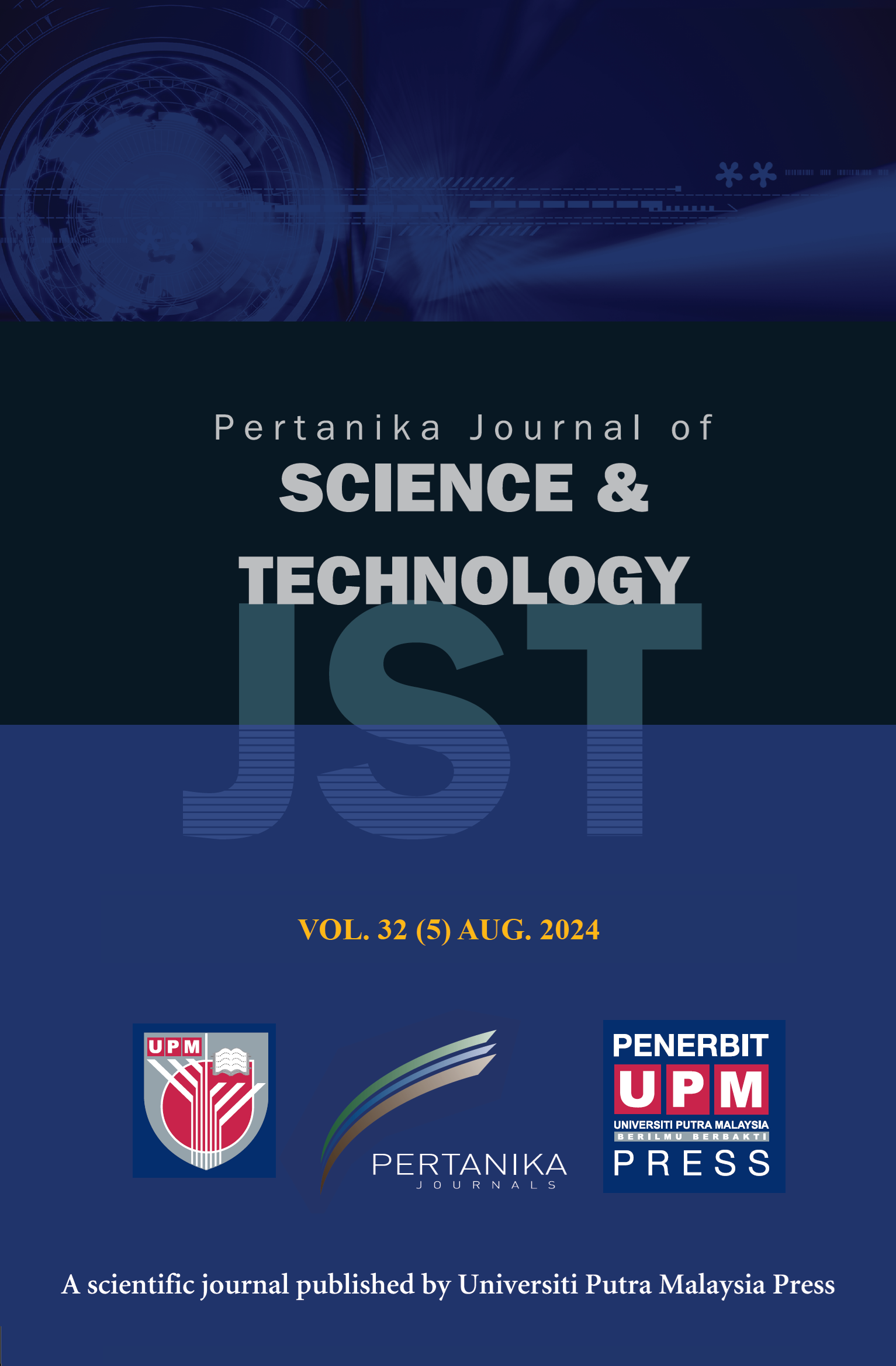PERTANIKA JOURNAL OF SCIENCE AND TECHNOLOGY
e-ISSN 2231-8526
ISSN 0128-7680
J
J
Pertanika Journal of Science & Technology, Volume J, Issue J, January J
Keywords: J
Published on: J
J
-
Aldous, C. (2008). Turning the tide: Transforming science learning and teaching in rural and remote schools. Teaching Science, 54(3), 44-48.
-
Asfar, N., & Zainuddin, Z. (2015). Secondary students’ perceptions of information, communication and technology (ICT) use in promoting self-directed learning in Malaysia. The Online Journal of Distance and Online Learning, 3(4), 74-89.
-
Aslan, A., & Zhu, C. (2018). Starting teachers’ integration of ICT into their teaching practices in the lower secondary schools in Turkey. Educational Sciences: Theory & Practice, 18(1), 23-45. http://dx.doi.org/10.12738/estp.2018.1.0431
-
Bazzer, S. (2016). ICT competencies and integration practices of public secondary school teachers in Lanao del Norte [Unpublished Master’s thesis]. University of the Philippines.
-
Buabeng-Andoh, C. (2012). Factors influencing teachers’ adoption and integration of information and communication technology into teaching: A review of the literature. International Journal of Education and Development using Information and Communication Technology, 8(1), 136-155.
-
Bensalem, E. (2019). English teachers’ perceptions of technology integration: Are they different from their peers in Engineering and Medical Science. International Journal of English Linguistics, 9(1), 152-158. https://doi.org/10.5539/ijel.v9n1p152
-
Collier-Reed, B. I., Case, J. M., & Stott, A. (2013). The influence of podcasting on student learning: A case study across two courses. European Journal of Engineering Education, 38(3), 329-339. https://doi.org/10.1080/03043797.2013.786026
-
Craciun, D., & Bunoiu, M. (2015). Training teachers for the Knowledge Society: Social media in science education. BRAIN. Broad Research in Artificial Intelligence and Neuroscience, 6(3-4), 82-88.
-
Creswell, J. W. (2014). Research design: Qualitative, quantitative and mixed methods approaches (4th ed.). Thousand Oaks, CA: Sage.
-
Department of Health. (n.d). What is GIDA? Retrieved June 30, 2019, from https://doh.gov.ph/faqs/What-is-GIDA
-
Donnelly, D., McGarr, O., & O-Reilly, J. (2011). A framework for teachers’ integration of ICT into their classroom practice. Computers & Education, 57(2), 1469-1483. https://doi.org/10.1016/j.compedu.2011.02.014
-
Goktas, Y., Yildirim, S., & Yildirim, Z. (2009). Main barriers and possible enablers of ICTs integration into pre-service teacher education programs. Educational Technology & Society, 12(1), 193-204.
-
Gurcay, D., Wong, B., & Chai, C. (2013). Turkish and Singaporean pre-service physics teachers’ beliefs about teaching and use of technology. Asia-Pacific Education Research, 22(2), 155-162.
-
Halili, S. H., & Sulaiman, H. (2019). Factors influencing the rural students’ acceptance of using ICT for educational purposes. Kasetsart Journal of Social Sciences, 40(3), 574-579. https://doi.org/10.1016/j.kjss.2017.12.022
-
Jimenez, A. B. (2005). The rural school and its teaching staff facing the challenge of the advancing information and communication technologies. In E. Blumel (Ed.), ICTE in regional development: Annual Proceedings of Vidzeme University College (pp. 8-11). Vidzeme University College.
-
Jimoyiannis, A. (2010). Designing and implementing an integrated technological pedagogical science knowledge framework for science teachers professional development. Computers & Education, 55(3), 1259-1269. https://doi.org/10.1016/j.compedu.2010.05.022
-
Krause, M., Pietzner, V., Dori, Y.J., & Eilks, I. (2017). Differences and developments in attitudes and self-efficacy of prospective Chemistry teachers concerning the use of ICT in education. Eurasia Journal of Mathematics Science and Technology Education, 13(8), 4405-4417. https://doi.org/10.12973/eurasia.2017.00935a
-
Lim, C. P. (2007). International Review: Effective integration of ICT in Singapore schools: Pedagogical and policy implications. Educational Technology Research and Development, 55, 83-116. https://doi.org/10.1007/s11423-006-9025-2
-
Lim, C. P., Tinio, V. L., Smith, M., & Bhowmik, M. K. (2018). Digital learning from developing Asian countries: Achieving equity, quality, and efficiency in education. In K. J. Kennedy & J. C.-K. Lee (Eds.), Routledge international handbook of schools and schooling in Asia. Routledge Taylor & Francis Group. https://doi.org/10.4324/9781315694382
-
Livingstone, S. (2012). Critical reflections on the benefits of ICT in education. Oxford Review of Education, 38(1), 9-24. https://doi.org/10.1080/03054985.2011.577938
-
Lu, C., Tsai, C.-C., & Wu, D. (2015). The role of ICT infrastructure in its application to classrooms: A large scale survey for middle and primary schools in China. Educational Technology & Society, 18(2), 249-261. https://doi.org/10.2307/jeductechsoci.18.2.249
-
Millanes, M. A. A., Paderna, E. E. S., & Que, E. N. (2018). Effects of utilizing Physics podcasts on the ICT literacy skills of Grade 9 junior high school students. Alipato: A Journal of Basic Education, 9, 14-24.
-
Mtebe, J. S., Dachi, H., & Raphael, C. (August 2011). Report: Integrating ICT into teaching and learning at the University of Dar es Salaam. Distance education, 32(2), 289-294. https://doi.org/10.1080/01587919.2011.584854
-
Philippine Official Gazette. (n.d.). Pantawid Pamilyang Pilipino Program. Retrieved June 30, 2019, from https://www.officialgazette.gov.ph/programs/conditional-cash-transfer/
-
Rogers, L., & Twidle, J. (2013). A pedagogical framework for developing innovative science teachers with ICT. Research in Science & Technological Education, 3(3), 227-251. https://doi.org/10.1080/02635143.2013.833900
-
Sahin, I. (2006). Detailed review of Rogers’ diffusion of innovations theory and educational technology-related studies based on Rogers’ theory. Turkish Online Journal of Educational Technology, 5(2), 14-23.
-
Steiner, D., & Mendelovitch, M. (2017). “I’m the same teacher”: The attitudes of science and computer literacy teachers regarding integrating ICT in instruction to advance meaningful learning. Eurasia Journal of Mathematics Science and Technology Education, 13(5), 1259-1282. https://doi.org/10.12973/eurasia.2017.00670a
-
Taimalu, M., & Luik, P. (2019). The impact of beliefs and knowledge on the integration of technology among teacher educators: A path analysis. Teaching and Teacher Education, 79, 101-110. https://doi.org/10.1016/j.tate.2018.12.012
-
Tearle, P. (2004). A theoretical and instrumental framework for implementing change in ICT in education. Cambridge Journal of Education, 34(3), 331-352. https://doi.org/10.1080/0305764042000289956
-
Ulla, M. B., Barrera, K. B., & Acompanado, M. M. (2017). Philippine classroom teachers as researchers: Teachers’ perceptions, motivations, and challenges. Australian Journal of Teacher Education, 42(11), 52-64. http://dx.doi.org/10.14221/ajte.2017v42n11.4
-
UNESCO. (2016). Diverse approaches to developing and implementing competency-based ICT training for teachers: A case study (Vol. 1). https://unesdoc.unesco.org/ark:/48223/pf0000246003
-
Wang, Q., & Woo, H. L. (2007). Systematic planning for ICT integration in topic learning. Educational Technology & Society, 10(1), 148-156.
-
Yin, R. K. (2003). Case study research: Design and methods (3rd ed.). Sage. https://iwansuharyanto.files.wordpress.com/2013/04/robert_k-_yin_case_study_research_design_and_mebookfi-org.pdf
ISSN 0128-7680
e-ISSN 2231-8526




